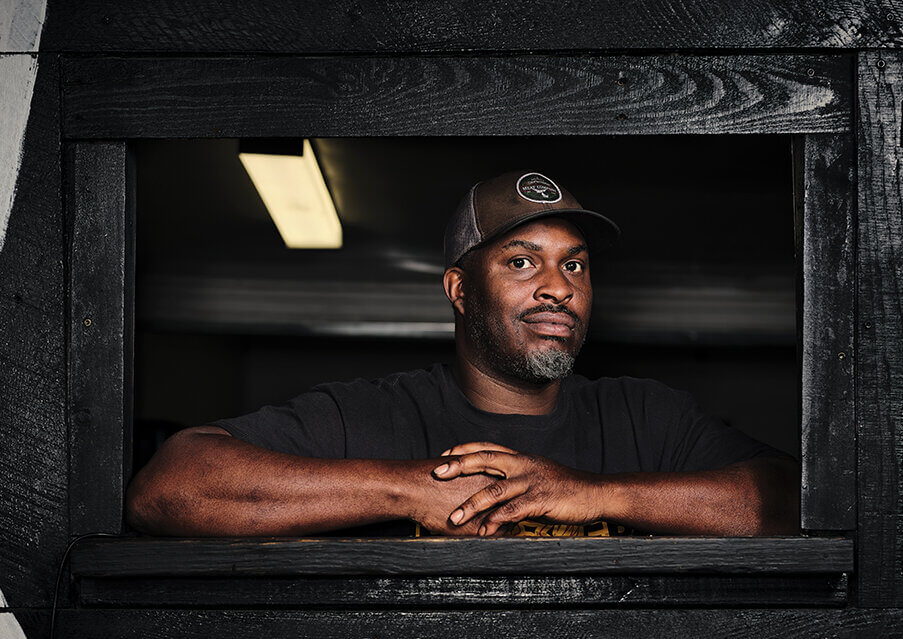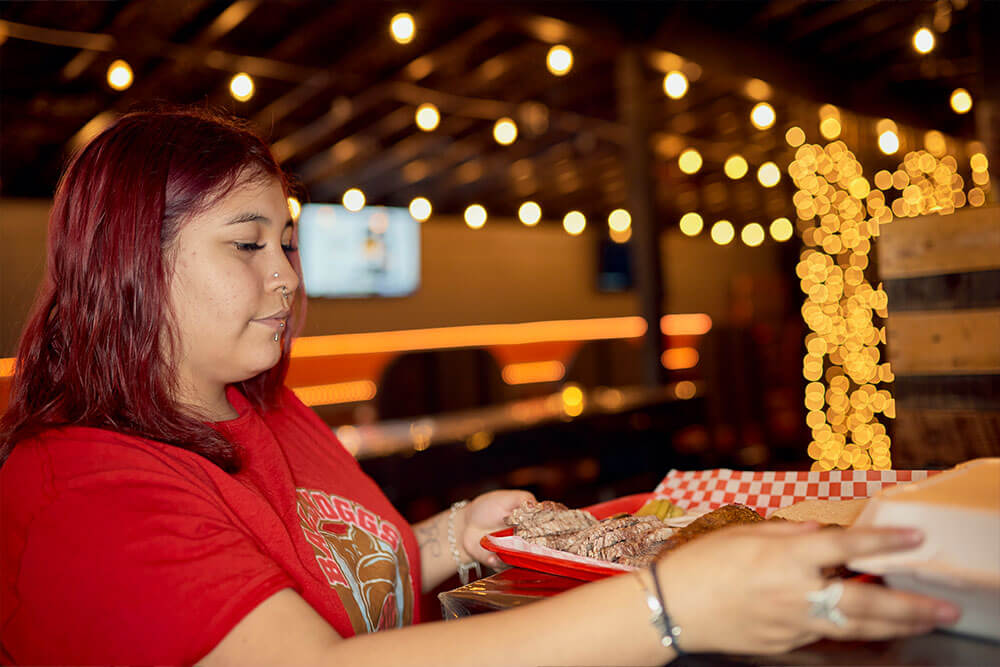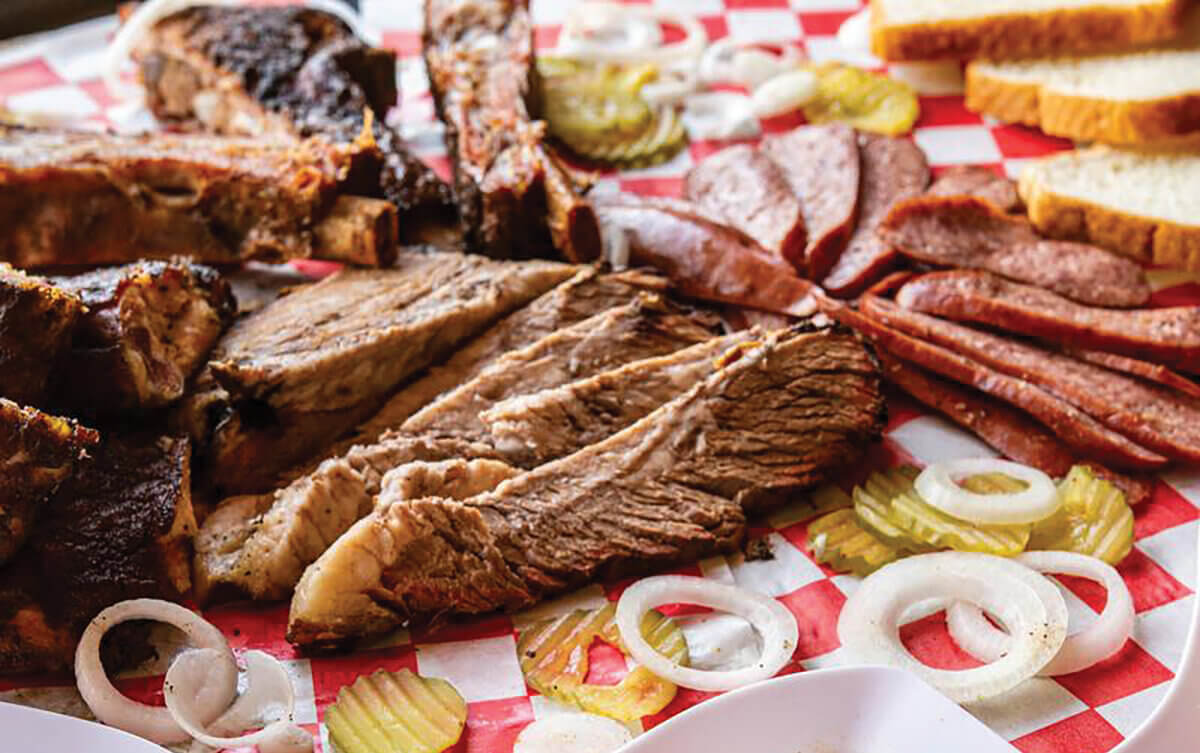

RUNNING A RESTAURANT IN ORDER TO REACH KIDS IS NOT FOR THE FAINT OF HEART.
GOOD THING HUBERT BROWN’S
HEART IS STRONG.
What kind of story do you want to read?
How about one about a teenage football player who comes to the game late, but his explosive athleticism catapults him all the way to a full-ride Division 1 scholarship?
Or one about a guy who is taught to run drugs at the same age most kids are learning to ride a bike? And how he is good at it—driving his own car by 13 and burying cash all around town until the inevitable bust?
How about when he tries his hand at rap music and finds that he’s good at that, too? Soon he finds himself on stage rapping before hundreds of kids, and he looks into the crowd and realizes: Wow, they know every word to my song.
Or how about later, when he becomes a trained first responder to violent crimes in San Antonio and he stays on call six evenings a week amid everything else he’s got going?
What about this one? A serial entrepreneur launches a restaurant just so he can mentor kids in his neighborhood. Hubert Brown—widely and affectionally known as Streetz—has lived all those stories and more. Too many stories to cover in this handful of pages. He’s the “Black Forrest Gump”—and note the quotation marks. Those are his words, not mine. It’s one of his favorite lines.
Brown is 45, a father of six and a father figure to many more. The story he’s living today is making possible new stories for other people in San Antonio.
It’s a lot to cover, but the good news is that you can enter the story by going to BallHoggs BBQ. It’s the closest restaurant to the AT&T Center, where the San Antonio Spurs play 41 nights a year and big musical acts perform and the San Antonio Stock Show & Rodeo happens every February. You’ll have lots of chances to get there.
Bring your ears, because if Brown isn’t too busy running the place, he’ll chat you up. And bring an empty belly, because his kitchen makes a scrumptious brisket grilled cheese sandwich, and you’re going to want to eat.
The King of Second Chances
Most teenagers who work at BallHoggs “come off the streets,” says Brown, much like he did a couple decades ago. How does he find them? He shrugs. “They just walk through that door. A lot of people in the neighborhood know what I’m doing here with the kids.”
When Brown hires a young person, he often starts them with “prep in the back, make the plates, cut the meat.” Then he’ll move them to the front, where they encounter customers, running the register and waiting tables.
Sometimes this professional development process goes smoothly. Sometimes it’s very hard—because, says Brown, “some of these kids are hard. They don’t got anybody to show them how to live.”
Brown tells the story of an 18-year-old named Jackie. (Her name has been changed for this story.) She grew up in nearby housing projects. “Rough upbringing,” says Brown. “Gang-banging. Selling drugs. Got a baby.”
She was a new mother “when she first came here. Never had a job. Had a bad attitude. I started her off in the back—she wasn’t fit to be with customers.”
Jackie didn’t like the kitchen and kept asking to move up. Brown relented—and soon regretted it when Jackie lit into a man who was upset about his order. Brown heard them arguing from the back and had to come calm things down and take care of the customer.
“You ain’t ready for the front,” he told her later. “But that guy was being a jerk,” she said. “It don’t matter,” Brown said. “The customer is always right—even when they’re wrong. It’s called ‘hospitality.’”
THE CUSTOMER IS ALWAYS RIGHT—EVEN WHEN THEY’RE WRONG. IT’S CALLED ‘HOSPITALITY.’
Sometime later, Jackie came to work one day and had her head down in the kitchen, plugging away, when a police officer named Kevin Bell stopped by.
Bell is a SAFFE officer (pronounced “safe,” it stands for San Antonio Fear Free Environment). His job is to engage the community—make connections, build relationships. Brown is on the short list of Eastside leaders with whom Bell stays in close contact.
On this particular day, Officer Bell was coming by to tell Brown about how he’d intercepted Jackie off the streets the night before.
Jackie had been out with a group of gang-affiliated kids, and they got involved in a shooting—Jackie took a shot to the shoulder—and then a car chase. She was not a prime suspect in the case, but while she was being interviewed in the back of a police cruiser by another officer, Bell saw her and thought he recognized her.
He definitely recognized what she was wearing: a BallHoggs T-shirt.

That is one of Streetz’s kids, Bell realized. Once the interview was over, Bell pulled Jackie aside.
“I told her to come to her senses,” Bell says. “I wanted her to understand the magnitude of what she was getting herself into—and who she was representing. After I told her I knew where she worked, her ears spiked up.”
Bell knew that moment could be a fork in Jackie’s road. “She could have been in deeper trouble,” he says. “But I would rather Hubert handle things in-house so she can think twice.”
The next day at BallHoggs, Bell wanted make sure Jackie understood something: the only reason she was not in worse trouble was that she was affiliated with Hubert Brown.
One of Brown’s local friends, Charles Foltz of the nonprofit GoodHood, jokingly calls him “the king of second chances.” And it works. The proof is in how Jackie is doing now.
“It changed her whole outlook,” says Brown with a toothy grin. She’s polite, works well with customers, and remains one of BallHoggs’ best employees.
The Kid’s Idea
Most teenagers, however, don’t remain at BallHoggs very long—and that is by design. Once Brown feels like a young employee has it all down—kitchen prep, handling money, working with customers—he does something very strange: he helps them find another job.
“We knock the rust off of ‘em, we move ‘em on,” he says. “Once we know they are consistent, coming in, have a strong work ethic, we move them to other restaurants.”
Sometimes that means other restaurants run by friends of Brown on the city’s Eastside—Tank’s Pizza, Mark’s Outing. Often it means other places Brown knows will look good on a kid’s résumé—Taco Bell, Whataburger. “Then they’re making $14-15 an hour,” Brown exclaims. “As a 10th grader! That’s real money in their pocket!”
He wants them to taste what it’s like to have a regular income—the ability to buy some clothes, get what they need for school. And he wants to spread that taste as fast and as far as possible among teenagers in the neighborhood.
I WANT TO MAKE SURE TO KEEP IT RUNNING SO THESE KIDS HAVE SOMEWHERE TO GO.
The restaurant only needs around six staff per day, but “the last two years since opening BallHoggs, I’ve had 47 kids who worked here,” Brown says. That might not sound like an efficient staffing model, but Brown’s goal was never to be a typical restauranteur.
“I do want to make money. I want to make sure to keep it running so these kids have somewhere to go,” he says. But, he adds, pointing around the inside of BallHoggs, “All of this was the kids’ idea.”
Building Power
BallHoggs emerged from a nonprofit called Power that Brown and some friends started back in 2014. Their initial goal was to run a summer program for high-risk kids—kids who were idle and thus easy pickings for local gangs.
The challenge is a phenomenal one in this part of San Antonio, where many families live on the front lines of the consequences of decades of our city’s social and economic neglect.
When Power launched its summer program in 2014, over 100 kids got involved.
Power provided different kinds of opportunities for the kids, one of which was business. That was Brown’s area to lead.

The first summer, they ran a lemonade stand business called Lemons into Lemonade. And they did it right, from soup to nuts (or, rather, rinds to juice). He took the young people down to the local business administration offices at City Hall and showed them how to apply for a permit. He helped the kids build the stands by hand. He had 36 kids, so they built 12 stands, then stationed three kids at each stand.
“One person made the lemonade and sold it,” remembers Brown. “One person calculated the money. One person was doing promotion and marketing. Every day, everybody switched jobs.”
The next year, the kids wanted to sell T-shirts. So they ran it all back—business permits, then purchasing shirts and ink (with profits from Lemons to Lemonade), then selling shirts at street interactions. One for $15, two for $20. They made $5,500 that summer.
In 2017, Brown gathered with a group of kids early in the year and asked them,
“So what we gonna do next year?”
Their answer: “Let’s start a restaurant!”
Brown laughed. “Don’t y’all know a restaurant is the hardest business to run?”
They told him they’d heard him loud and clear, but they’d also heard something else: “You told us you can do whatever you put your mind to.”
“DON’T Y’ALL KNOW A RESTAURANT IS THE HARDEST BUSINESS TO RUN?”
“YOU TOLD US YOU CAN DO WHATEVER YOU PUT YOUR MIND TO.”
The story of how they got from that idea to launching BallHoggs is another good one. Brown did not know anything about running a restaurant, the building he had access to was in shambles, and no one had successfully operated a small business near the AT&T Center in the 20 years since the arena was built.
But Brown wasn’t going to let anything stand in the way… Again, it’s a good story, and I’d love to tell it to you. But we’re out of space. To hear it, you’re going to have to listen to the man himself.
It’s worth pausing for a moment to note why this story exists in the first place—why someone like Streetz has to dedicate so much of his time and money and energy to helping kids in his neighborhood. Why is the need so great and so urgent?
In some parts of San Antonio, kids have every imaginable opportunity to get ahead in life: stable families, resource-rich schools, ample summer programs, easy access to parks and athletics, and so on.
But in other parts of town, kids face roadblocks at every turn.
The reasons for these neighborhood-based gaps in opportunity are complex. But the place to begin understanding them is by looking into our city’s past, including injustices that shaped the way our city was originally designed and how that design has been reinforced over the decades since.
If you’re curious to know more, visit KnowYourNeighbor.com. For starters, watch “Making San Antonio,” a short overview about the city’s history of housing development.
Also, check out the article “How Our Neighborhoods Impact Our Health.”
Ultimately, these realities cannot change unless we cultivate connections between neighbors. Know Your Neighbor is a storytelling project designed to help us do just that—to tell an accurate story about our gaps in opportunity so that we can all come to see, know, and love our neighbors as ourselves.
Know Your Neighbor's Third Thursdays allows guests to learn from the stories of San Antonio leaders.
American Indians of Texas and the Foundation came together to better understand which tribes specifically would have visited the Canyon.
President David Rogers reflects on how our programs reflect our spiritual formation values and our desire to help families and children.